ACHYUTA RAYAS TEMPLE
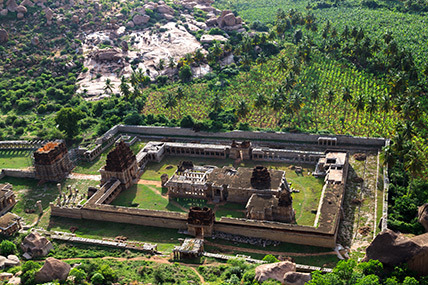 Amongst the last grand temples to be consecrated was the Achyuta Rayas temple. Dedicated to Lord Tiruvengalanatha (a form of Lord Vishnu), this temple is probably the most advanced among all the temples in Vijayanagara empire.
Amongst the last grand temples to be consecrated was the Achyuta Rayas temple. Dedicated to Lord Tiruvengalanatha (a form of Lord Vishnu), this temple is probably the most advanced among all the temples in Vijayanagara empire.
The Vijayanagar dynasty’s emblem which has a boar, the sun, a sword & the moon on it, can be seen on the entrance gateway. Apart from the central shrine, the intricately carved pillars in the courtyards of the temple will surely mesmerize.
BHIMA’S GATE
An example of a robust military system, Bhima’s gate was very intelligently designed to create a blind spot for the invaders. The unique feature of this structure is that no one can cross this gateway in a straight line! The gateway is adorned with beautiful carvings & murals.
VIRUPAKSHA TEMPLE
 Amongst the oldest functioning temples of India, this temple is believed to exist since 7th century AD. It was under the rule of King Krishna Deva Raya II that the temple seems to have expanded widely encompassing beautiful pillared halls & huge gateways. Dedicated to Hindu God Lord Shiva, it is the holiest of all temples in Hampi.
Amongst the oldest functioning temples of India, this temple is believed to exist since 7th century AD. It was under the rule of King Krishna Deva Raya II that the temple seems to have expanded widely encompassing beautiful pillared halls & huge gateways. Dedicated to Hindu God Lord Shiva, it is the holiest of all temples in Hampi.
The giant entrance tower in east, also known as the eastern gateway, will fascinate the most which is a 9 storied tower with a pair of horn like projections. A must visit in the complex is Ranga Mandapa with ceiling having some original Vijayanagar paintings.
During a visit one should not miss to take blessing of temple elephant who usually greet the people entering from eastern gateway!
Insider Tip: Visit Hampi in the month of March / April and be a part of the Virupaksha chariot (car) festival celebrated at the temple. The annual festival marks the divine ritual marriage between the deities Virupaksheshwara & Pampa. A giant wooden chariot (temple car) with image of god & goddess pulled along the streets of Hampi Bazaar is the main attraction of this colorful procession.
HAMPI BAZAAR & RIVERSIDE RUINS
Located in front of Virupaksha temple, Hampi Bazaar was a bustling market at one point of time. Merchants, not only from the surrounding areas but also from other countries used to come and sell their products here. There is a reference to this bazaar in traveler Abdur Razzaq’s account as well where he mentioned that people used to sell semi precious stones & diamonds amongst other things. Even cows & horses were traded here! Though the market is not as impressive today as it used to be, it is still functioning as a market where one may find vendors selling traditional costumes, antique coins etc.
Insider Tip: Follow the path that connects the ancient Hampi Bazaar to the Vittala temple to discover a number of shrines, carved artifacts and ruins of ancient structures which are dotted along this path.
ROYAL ENCLOSURE
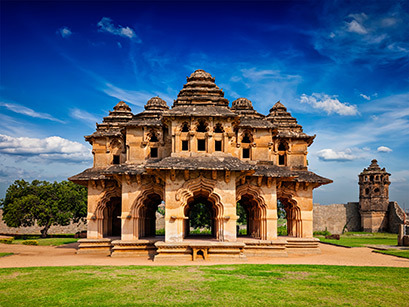
Royal enclosure, the huge fortified area, was the seat of power of Vijayanagara kingdom. This area is dotted with ruins of a number of a structures like palace bases, underground temples, Royal stables etc.
One of the most prominent structure here is Mahanavami Dibbaa or the Dussehra platform which was used by the king to watch the parade during the Dussehra celebrations.
HAZARA RAMA TEMPLE

The most intricately carved temple, Hazara Rama temple was the private temple of the king. The carvings depicting stories from Hindu Epic Ramayana are very impressive and are sure to keep one engrossed for a long time.
The four black polished pillars in the inner shrine, adorned with chiseled bas reliefs of Hindu gods like Ganesha, Mahishasurmardini, Hanuman & forms of Vishnu, are worth a visit.
PUSHKARINI OR STEP WELL

The ancient step wells are called ‘Pushkarinis’ in Karnataka. They are not as elaborate as the ones found in western India but they are still the architectural marvels in themselves. Out of many Pushkarini’s in Hampi the most intricate is the one located in the ruins of Royal enclosures of Hampi.
Usage of blocks of black schist stones is the unique feature of this Pushkarini. This tank is perfectly symmetrical & is a classic example of the mastery of local artisans.
ELEPHANT STABLES
Gajshala or the elephant stables were the shelter for the royal elephants. One of the impressive structures in royal enclosure, these are a series of 11 stables with dome shaped roof.
THE AMAZING AQUEDUCTS & CANAL SYSTEM OF HAMPI
What one will be very impressed with is the meticulous town planning of Hampi. The palaces, temples, markets, and houses everything was well planned & executed. The water management system of the city makes one wonder how proficient these people were in engineering. Keeping the welfare of people in mind, aqueducts & tanks were constructed throughout the city so that the people didn’t had to go to the river to fetch water rather the water would reach every household through the perfect system of aqueducts & water canals which crisscross through the whole city.

An aqueduct, unlike a canal is raised above the ground like a pipeline. Hampi was at an elevation from Tungabhadra River, which was at a lower height. The challenge was to bring the water through these aqueducts from a low elevation to a high elevation.
They achieved this troublesome exploit by making a gating system or gate-locking system, whereby water was sent from one chamber to another chamber and lifted to the aqueducts and sent to the tanks.
Though most of the aqueducts are in ruins now, one will be able to guess the scale of aqueducts from Bukka’s aqueduct.
Insider Tip: The best way to explore this historical town is by bicycles as it allows soaking in the history of this ancient place at own pace thus making the experience much more interesting. Our local guides who know the place inside out will enhance this experience with their knowledge of cycling routes & interesting tales / stories.
BOULDERING IN HAMPI
With its giant boulders that are split apart vertically, Bouldering in Hampi is an experience in itself. Whether an amateur or an experienced boulderer, there are ideal difficulty levels available for all.
WILDLIFE AROUND HAMPI

For the wildlife enthusiasts, Daroji Bear Sanctuary is just apt. There are high chances to spot Indian Sloth bears here. Some beautiful species of birds & other wildlife are bonus.
One can also take a trip to Matanga Hills & Nava Vrindavan to spot birds. Amongst the most famous ones frequenting the area are Painted Sandgrouse, Painted Spurfowl, Indian Eagle Owl & Yellow throated Bulbul. The lucky ones may also spot the elusive Leopard.
LAKKUNDI TEMPLES & PUSHKARINI
A trip to the forgotten village of Lakkundi or Lokki Gundi, about 100 km from Hampi, is a delight for someone who is keen to explore the surroundings and see some more rare pieces of history. This village has more than 100 ruined temples & sacred wells known as Pushkarinis. Though not all temples have stood the test of time, there are few which are in good shape.
Kashivishvanatha temple with intricate designs on the shikhara & doorways stands out amongst all. The exquisitely carved pillars of the temples will leave one speechless.
Brahma Jinalaya, a Jain temple is dedicated to Lord Mahavira. There is a 4 feet tall statue of Lord Mahavir in the main sanctum. The intricately carved doorway reflects the perfection of the artisans. The other examples of master craftsmanship which will attract attention in this temple are the four faced statutes of Hindu God Brahma & Goddess Saraswati.
Inhabited since pre-historic times, the historical antiquity of the Hampi region can be traced back to the Mauryan period, (322BCE – 182 BCE). Today the city stands as a mute spectator to its past glory and boasting of many beautiful structures still standing tall and showcasing the unique art and architecture of the Vijayanagara period. With us, the itinerary is not just a travel route or a trip. We design, conceptualize and handcraft every journey for you. Our bespoke itineraries and curated experiences in different destinations are what make for those memorable travel moments.

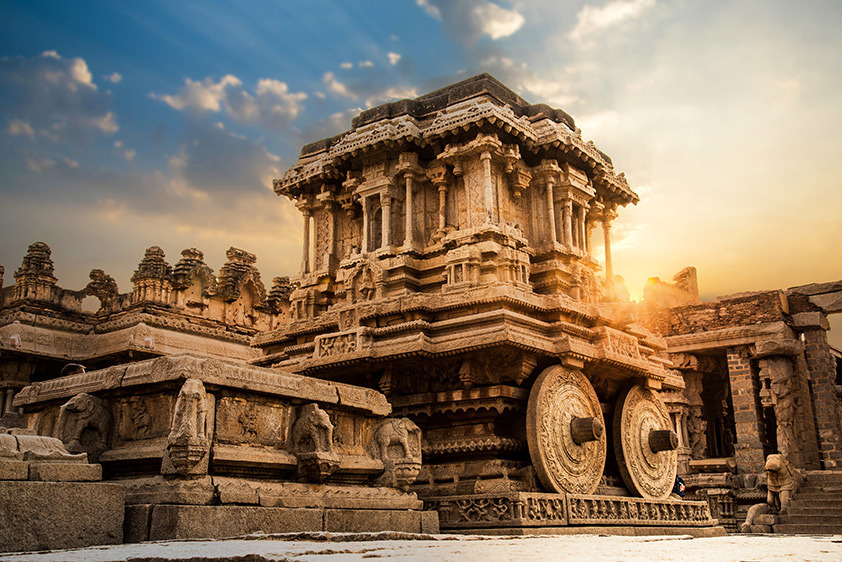 One will be amazed to see the best defense systems of those times in the empire. The massive walls, the watchtowers located strategically & huge gateways through which even the elephants could pass, all contributed to the robust military system which was one of the main reasons why this kingdom was almost invincible for such a long time. The system was so designed that if there was an attack from any side, the soldiers at the watchtowers would immediately be able to alert everyone about the attack.
One will be amazed to see the best defense systems of those times in the empire. The massive walls, the watchtowers located strategically & huge gateways through which even the elephants could pass, all contributed to the robust military system which was one of the main reasons why this kingdom was almost invincible for such a long time. The system was so designed that if there was an attack from any side, the soldiers at the watchtowers would immediately be able to alert everyone about the attack.
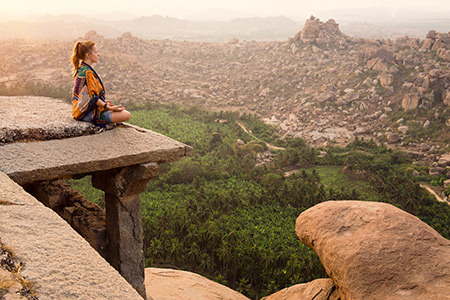 Later the entire monkey army was sent to Sri Lanka to get Sita released from Ravana. In return Lord Rama helped in killing Bali and reinstalled Sugreev as the King of Monkey kingdom.
Later the entire monkey army was sent to Sri Lanka to get Sita released from Ravana. In return Lord Rama helped in killing Bali and reinstalled Sugreev as the King of Monkey kingdom.
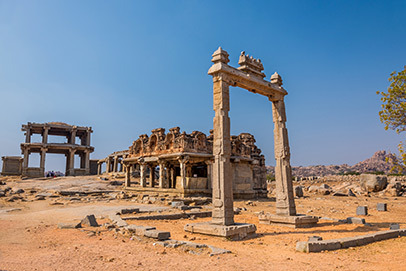 Tulapurushandana or King’s balance as it is called is another interesting structure. This archway like balance was used to weigh the Vijayanagara Kings in gold & other precious stones.
Tulapurushandana or King’s balance as it is called is another interesting structure. This archway like balance was used to weigh the Vijayanagara Kings in gold & other precious stones.
 Amongst the last grand temples to be consecrated was the Achyuta Rayas temple. Dedicated to Lord Tiruvengalanatha (a form of Lord Vishnu), this temple is probably the most advanced among all the temples in Vijayanagara empire.
Amongst the last grand temples to be consecrated was the Achyuta Rayas temple. Dedicated to Lord Tiruvengalanatha (a form of Lord Vishnu), this temple is probably the most advanced among all the temples in Vijayanagara empire.
 Amongst the oldest functioning temples of India, this temple is believed to exist since 7th century AD. It was under the rule of King Krishna Deva Raya II that the temple seems to have expanded widely encompassing beautiful pillared halls & huge gateways. Dedicated to Hindu God Lord Shiva, it is the holiest of all temples in Hampi.
Amongst the oldest functioning temples of India, this temple is believed to exist since 7th century AD. It was under the rule of King Krishna Deva Raya II that the temple seems to have expanded widely encompassing beautiful pillared halls & huge gateways. Dedicated to Hindu God Lord Shiva, it is the holiest of all temples in Hampi.



 An aqueduct, unlike a canal is raised above the ground like a pipeline. Hampi was at an elevation from Tungabhadra River, which was at a lower height. The challenge was to bring the water through these aqueducts from a low elevation to a high elevation.
An aqueduct, unlike a canal is raised above the ground like a pipeline. Hampi was at an elevation from Tungabhadra River, which was at a lower height. The challenge was to bring the water through these aqueducts from a low elevation to a high elevation.
 For the wildlife enthusiasts, Daroji Bear Sanctuary is just apt. There are high chances to spot Indian Sloth bears here. Some beautiful species of birds & other wildlife are bonus.
For the wildlife enthusiasts, Daroji Bear Sanctuary is just apt. There are high chances to spot Indian Sloth bears here. Some beautiful species of birds & other wildlife are bonus.
 Thank you, patrons, for reposing faith in our destinations and enquiring for customised virtual destination awareness training programs. We are proud to conduct them successfully so far and are looking forward to hold similar virtual destination awareness training programs for your team or yourself or a virtual tour for your clients. Let us know the destination of your interest along with your convenient date / time and we will be happy to set up a program for you.
Thank you, patrons, for reposing faith in our destinations and enquiring for customised virtual destination awareness training programs. We are proud to conduct them successfully so far and are looking forward to hold similar virtual destination awareness training programs for your team or yourself or a virtual tour for your clients. Let us know the destination of your interest along with your convenient date / time and we will be happy to set up a program for you.



